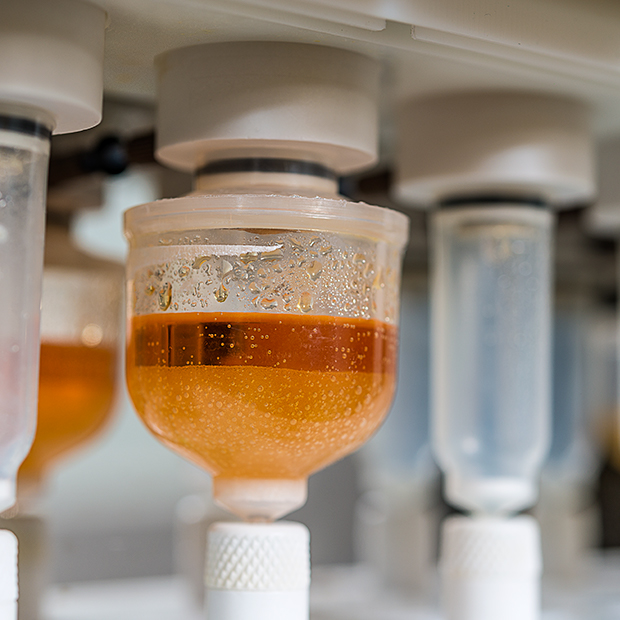Custom peptides synthesis
Hydrocarbon Stapled Peptides
AnaSpec offers an adaptable platform for the custom synthesis of stapled peptides catering to a variety of biological applications.
Protein-protein interaction studies, alpha-helix stability, cell permeability and in vivo PK studies are some of the research areas stapling technology confers its roles.
Stapling configurations
The hydrocarbon stapled peptides can be synthesized by solid-phase peptide synthesis, wherein two α-methyl, α-alkenyl containing amino acids when incorporated generates crosslinks with the α,α-disubstituted amino acids bearing olefinic chains of variable lengths at positions, "i" and "i+3", "i" and "i+4" or "i" and "i+7" (where "i" represents the first staple position) along the peptide sequence. This is followed by ring closure, deprotection and cleavage of the peptide from the solid support.
The design of stapled peptides follows incorporation of non-natural amino acids at specific sites along the desired peptide
to form the "staples" (hydrocarbon cross-link).
In i & i+3 stapled peptides, there are two amino acids between the staples.
Featured Citations
In i & i+4 stapled peptides, there are three amino acids between the staples.
i & i+4 stapled peptides generate the most optimally stabilized pattern
Featured Citations
- Membrane permeability of hydrocarbon-cross-linked peptides
- Rational optimization of conformational effects induced by hydrocarbon staples in peptides and their binding interfaces.
- Novel structures of self‐associating stapled peptides.
- A readily applicable strategy to convert peptides to peptoid-based therapeutics.
- Helix stabilization of amphipathic peptides by hydrocarbon stapling increases cholesterol efflux by the ABCA1 transporter.
In i & i+7 stapled peptides, there are six amino acids between the staples.
Featured Citations
Applications
- Stabilizing alpha helical conformations
- Disrupting protein-protein interactions (PPIs)
- Resisting proteases
- Permeating cell membranes
- Bioactivity
Specifications
- Length : Up to 60 amino acids.
- Purity : >95%, >90%, >85%, >70% or crude
- Quantity : 1 mg minimum up to gram quantities, delivered as gross weight or net weight.
Other constrained peptides
Featured Citations
Pharmacological inhibition of β-catenin/BCL9 interaction overcomes resistance to immune checkpoint blockades by modulating Treg cells.
Feng M, Jin JQ, Xia L, Xiao T, Mei S, Wang X, Huang X, Chen J, Liu M, Chen C, Rafi S.
Science advances. 2019 May 1;5(5):eaau5240.
DOI : 10.1126/sciadv.aau5240
The authors in this study developed hydrocarbon stapled peptides serving as potent inhibitors of the Wnt/β-catenin pathway implicated in cancer. A set of peptides including hsBCL9CT-24 were selected and in an effort to advance BCL9-targeted peptides towards clinical use, they were modified and optimized with staples.
The study showed that these peptides could overcome resistance to immune checkpoint therapies in multiple cancer types with favorable PK and toxicological properties, thereby providing scope for these peptides to advance cancer therapeutics.
From AnaSpec: Peptides were produced in AnaSpec, CA, according to previous protocols.
Inhibition of nutlin-resistant HDM2 mutants by stapled peptides.
Wei SJ, Joseph T, Chee S, Li L, Yurlova L, Zolghadr K, Brown C, Lane D, Verma C, Ghadessy F.
PLoS One. 2013;8(11).
DOI : 10.1371/journal.pone.0081068
In this study, Wei et al demonstrated that stapled p53-peptide analogs can function as ligands capable of reverting a drug-resistant phenotype due to mutation in HDM2.
From AnaSpec: Stapled peptides (sTIP) with an (i, i + 3) hydrocarbon linkage were generated by replacing the respective amino acids with the olefin-bearing unnatural amino acids (R)-2-(4′pentenyl) alanine and (S)-2-(4′-pentenyl) alanine and stapled, via olefin metathesis, using the Grubbs catalyst.
Rational optimization of conformational effects induced by hydrocarbon staples in peptides and their binding interfaces.
Lama D, Quah ST, Verma CS, Lakshminarayanan R, Beuerman RW, Lane DP, Brown CJ.
Scientific reports. 2013 Dec 13;3(1):1-0.
DOI : 10.1038/srep03451
The authors studied molecular dynamics simulations for a set of rationally designed stapled peptides in solution and in complex with a frequently over-expressed protein complex, eIF4E. The study revealed the effects of incorporating staples into helices targeting binding interactions to enable design of peptidomimetics as potential lead compounds against biomarkers such as eIF4E.
From AnaSpec: Stapled peptides (sTIP) with an (i, i + 4) hydrocarbon linkage were generated by replacing the respective amino acids with the olefin-bearing unnatural amino acids (S)-2-(4′pentenyl) alanine and (S)-2-(4′-pentenyl) alanine and stapled, via olefin metathesis, using the Grubbs catalyst. Stapled peptides (sTIP) with an (i, i + 3) hydrocarbon linkage were generated by replacing the respective amino acids with the olefin-bearing unnatural amino acids (R)-2-(4′pentenyl) alanine and (S)-2-(4′-pentenyl) alanine and stapled, via olefin metathesis, using the Grubbs catalyst.
Membrane permeability of hydrocarbon-cross-linked peptides
Sun TL, Sun Y, Lee CC, Huang HW.
Biophysical journal. 2013 May 7;104(9):1923-32.
DOI : 10.1016/j.bpj.2013.03.039
Sun T-L et al, 2013 stabilized a peptide through a hydrocarbon stapled linker and studied the effects of peptide stapling on membrane permeability. They observed that a 12-mer peptide, NYAD-1 permeates lipid membranes compared to a native peptide even at low concentrations and concluded that the hydrocarbon link provided an amphiphathic molecular surface to an otherwise hydrophilic peptide with membrane-binding affinity as well as membrane-interacting property similar to AMPs.
From AnaSpec: NYAD-2 is FITC - (beta - Ala) - Ile - Thr - Phe - X - Asp - Leu - Leu - X - Tyr - Tyr - Gly - Pro - NH2 (with special cyclization to get double bond, X = (S) - alpha - (2′- pentenyl)alanine; FITC = fluorescein isothiocyanate).
A readily applicable strategy to convert peptides to peptoid-based therapeutics.
Park M, Wetzler M, Jardetzky TS, Barron AE.
PloS one. 2013;8(3).
DOI : 10.1371/journal.pone.0058874
Park M et al, have proposed a readily-applicable combined scanning approach for identifying peptoid-replaceable peptide residues, which explores the conformational tolerance and relevance of individual side chains in the target peptide sequence, providing information not obtained from typical structural studies. Based on introducing staples, strategy presented seems to be useful in other peptide ligand systems (e.g., β-turn mimics and miniature protein scaffolds), providing a critical design paradigm for future therapeutic peptidomimetics.
From AnaSpec: A resulting peptide stapled at (i, i + 4) positions (ISQVNEKINQSLXFIRXSDE, X for hydrocarbon staples), SC20, was commercially obtained from Anaspec (San Jose, CA, USA) with final purity (> 90%).
Structure of a stapled peptide antagonist bound to nutlin-resistant Mdm2.
Chee SM, Wongsantichon J, Tng QS, Robinson R, Joseph TL, Verma C, Lane DP, Brown CJ, Ghadessy FJ.
PLoS One. 2014;9(8).
DOI : 10.1371/journal.pone.0104914
In this study, the authors developed a stapled peptide antagonist bound to Nutilin resistant Mdm2 and examined the properties of binding via interactions with Mdm2. The study provided evidence for hydrocarbon stapled moieties to be used for improved binding to target molecules such as Mdm2, a p53 tumor suppressor.
From AnaSpec: The (i, i +7) hydrocarbon linkage was generated by placing the olefin-bearing unnatural amino acids (S)-2-(49pentenyl) alanine and (S)-2-(79-octenyl) alanine at positions 4 and 11, respectively. These were then fused via olefin metathesis using the Grubbs catalyst.
Novel structures of self‐associating stapled peptides.
Bhattacharya S, Zhang H, Cowburn D, Debnath AK.
Biopolymers. 2012 May;97(5):253-64.
DOI : 10.1038/srep03451
The challenges encountered during design of bioactive stapled peptides have been outlined in this study with respect to structure, length and position of the staples with underlying hydrophobic interactions driven between olefinic chain and aromatic side-chains of peptides. The conclusions render broad implications to optimize new class of compounds in drug discovery.
From AnaSpec: The stapled peptides with greater than 90% purity were synthesized by Anaspec.
Helix stabilization of amphipathic peptides by hydrocarbon stapling increases cholesterol efflux by the ABCA1 transporter.
Sviridov DO, Ikpot IZ, Stonik J, Drake SK, Amar M, Osei-Hwedieh DO, Piszczek G, Turner S, Remaley AT.
Biochemical and biophysical research communications. 2011 Jul 8;410(3):446-51.
DOI : 10.1016/j.bbrc.2011.05.154
The authors studied hydrocarbon stapling of amphipathic peptides (Apolipoprotein mimetic peptides) and showed that stapling increases their helicity, makes them resistant to proteolysis and enhances their ability to promote cholesterol efflux by the ABCA1 transporter. Such a peptide modification could be useful in the development of apolipoprotein mimetic peptides, concluded the authors.
From AnaSpec: A peptide based on the last helix of apoA-I (A10) (Ac-VLDSFKVSFLSALEEYTKKLNTQ-NH2) and 2 stapled variants of this peptide, referred to as S1A10 and S2A10, were made by solid phase synthesis, using standard Fmoc chemistry and the Fmoc-modified amino acid linkers ((R)-a-(7′-octanyl)Ala and (S)-a-(4′-pentenyl)Ala)



